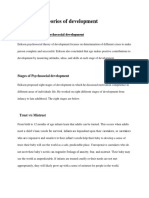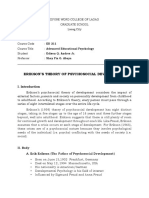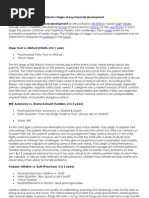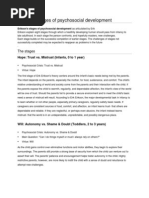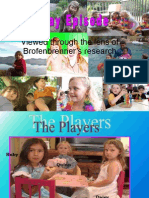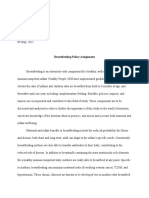0 ratings0% found this document useful (0 votes)
77 viewsErikson's Theory: Trust vs. Mistrust
Erikson's Theory: Trust vs. Mistrust
Uploaded by
Joshua JimenezErik Erikson developed a theory of psychosocial development consisting of eight stages from infancy to late adulthood. At each stage, individuals face a psychosocial crisis that influences their development. For example, infants must develop trust versus mistrust by having their needs met consistently by caregivers. School-aged children experience industry versus inferiority by comparing themselves to peers. In adolescence, individuals grapple with identity versus role confusion as they develop a sense of self.
Copyright:
© All Rights Reserved
Available Formats
Download as DOCX, PDF, TXT or read online from Scribd
Erikson's Theory: Trust vs. Mistrust
Erikson's Theory: Trust vs. Mistrust
Uploaded by
Joshua Jimenez0 ratings0% found this document useful (0 votes)
77 views4 pagesErik Erikson developed a theory of psychosocial development consisting of eight stages from infancy to late adulthood. At each stage, individuals face a psychosocial crisis that influences their development. For example, infants must develop trust versus mistrust by having their needs met consistently by caregivers. School-aged children experience industry versus inferiority by comparing themselves to peers. In adolescence, individuals grapple with identity versus role confusion as they develop a sense of self.
Original Description:
DASD
Original Title
Erikson
Copyright
© © All Rights Reserved
Available Formats
DOCX, PDF, TXT or read online from Scribd
Share this document
Did you find this document useful?
Is this content inappropriate?
Erik Erikson developed a theory of psychosocial development consisting of eight stages from infancy to late adulthood. At each stage, individuals face a psychosocial crisis that influences their development. For example, infants must develop trust versus mistrust by having their needs met consistently by caregivers. School-aged children experience industry versus inferiority by comparing themselves to peers. In adolescence, individuals grapple with identity versus role confusion as they develop a sense of self.
Copyright:
© All Rights Reserved
Available Formats
Download as DOCX, PDF, TXT or read online from Scribd
Download as docx, pdf, or txt
0 ratings0% found this document useful (0 votes)
77 views4 pagesErikson's Theory: Trust vs. Mistrust
Erikson's Theory: Trust vs. Mistrust
Uploaded by
Joshua JimenezErik Erikson developed a theory of psychosocial development consisting of eight stages from infancy to late adulthood. At each stage, individuals face a psychosocial crisis that influences their development. For example, infants must develop trust versus mistrust by having their needs met consistently by caregivers. School-aged children experience industry versus inferiority by comparing themselves to peers. In adolescence, individuals grapple with identity versus role confusion as they develop a sense of self.
Copyright:
© All Rights Reserved
Available Formats
Download as DOCX, PDF, TXT or read online from Scribd
Download as docx, pdf, or txt
You are on page 1of 4
Erikson’s Theory
Erik Erikson (1902–1994) was a stage theorist who took Freud’s
controversial theory of psychosexual development and modified it as a
psychosocial theory. Erikson emphasized that the ego makes positive
contributions to development by mastering attitudes, ideas, and skills at each
stage of development. This mastery helps children grow into successful,
contributing members of society. During each of Erikson’s eight stages, there
is a psychological conflict that must be successfully overcome in order for a
child to develop into a healthy, well-adjusted adult.
Stages of Psychosocial Development
Erikson’s stages of psychosocial development are based on Freud’s
psychosexual theory. Erikson proposed that we are motivated by the need
to achieve competence in certain areas of our lives. According to
psychosocial theory, we experience eight stages of development over our
lifespan, from infancy through late adulthood. At each stage there is a crisis
or task that we need to resolve. Successful completion of each
developmental task results in a sense of competence and a
healthy personality. Failure to master these tasks leads to feelings of
inadequacy.
Trust vs. Mistrust
From birth to 12 months of age, infants must learn that adults can be trusted.
This occurs when adults meet a child’s basic needs for survival. Infants are
dependent upon their caregivers, so caregivers who are responsive and
sensitive to their infant’s needs help their baby to develop a sense of trust;
their baby will see the world as a safe, predictable place. Unresponsive
caregivers who do not meet their baby’s needs can engender feelings
of anxiety, fear, and mistrust; their baby may see the world as unpredictable.
If infants are treated cruelly or their needs are not met appropriately, they will
likely grow up with a sense of mistrust for people in the world.
Autonomy vs. Shame/Doubt
As toddlers (ages 1–3 years) begin to explore their world, they learn that they
can control their actions and act on their environment to get results. They
begin to show clear preferences for certain elements of the environment,
such as food, toys, and clothing. A toddler’s main task is to resolve the issue
of autonomy vs. shame and doubt by working to establish independence.
Initiative vs. Guilt
Once children reach the preschool stage (ages 3–6 years), they are capable
of initiating activities and asserting control over their world through social
interactions and play. According to Erikson, preschool children must resolve
the task of Initiative vs. Guilt. By learning to plan and achieve goals while
interacting with others, preschool children can master this task. Initiative, a
sense of ambition and responsibility, occurs when parents allow a child to
explore within limits and then support the child’s choice.
Industry vs. Inferiority
During the elementary school stage (ages 6–12), children face the task
of industry vs. inferiority. Children begin to compare themselves with their
peers to see how they measure up. They either develop a sense of pride and
accomplishment in their schoolwork, sports, social activities, and family life,
or they feel inferior and inadequate because they feel that they don’t
measure up. If children do not learn to get along with others or have negative
experiences at home or with peers, an inferiority complex might develop
into adolescence and adulthood.
Identity vs. Role Confusion
In adolescence (ages 12–18), children face the task of identity vs. role
confusion. According to Erikson, an adolescent’s main task is developing a
sense of self. Adolescents struggle with questions such as “Who am I?” and
“What do I want to do with my life?” Along the way, most adolescents try on
many different selves to see which ones fit; they explore various roles and
ideas, set goals, and attempt to discover their “adult” selves.
Intimacy vs. Isolation
People in early adulthood (20s through early 40s) are concerned
with intimacy vs. isolation. After we have developed a sense of self in
adolescence, we are ready to share our life with others. However, if other
stages have not been successfully resolved, young adults may have trouble
developing and maintaining successful relationships with others. Erikson
said that we must have a strong sense of self before we can develop
successful intimate relationships. Adults who do not develop a positive self-
concept in adolescence may experience feelings of loneliness and emotional
isolation.
Generativity vs. Stagnation
When people reach their 40s, they enter the time known as middle
adulthood, which extends to the mid-60s. The social task of middle adulthood
is generativity vs. stagnation. Generativity involves finding your life’s work
and contributing to the development of others through activities such as
volunteering, mentoring, and raising children.
Integrity vs. Despair
From the mid-60s to the end of life, we are in the period of development
known as late adulthood. Erikson’s task at this stage is called integrity vs.
despair. He said that people in late adulthood reflect on their lives and feel
either a sense of satisfaction or a sense of failure. People who feel proud of
their accomplishments feel a sense of integrity, and they can look back on
their lives with few regrets. However, people who are not successful at this
stage may feel as if their life has been wasted. They focus on what “would
have,” “should have,” and “could have” been. They face the end of their lives
with feelings of bitterness, depression, and despair.
CLYDE ELYZE C. DELA CRUZ
You might also like
- Demonstrate Knowledge of The Stages of Child DevelopmentDocument64 pagesDemonstrate Knowledge of The Stages of Child DevelopmentAvaNo ratings yet
- Task 9 Erikson's Psychosocial Theory DevelopmentDocument3 pagesTask 9 Erikson's Psychosocial Theory DevelopmentChanie Baguio PitogoNo ratings yet
- Erik Erikson'S (8 SPD) 8 Stages of Psychosocial DevelopmentDocument2 pagesErik Erikson'S (8 SPD) 8 Stages of Psychosocial DevelopmentCath Domingo - LacisteNo ratings yet
- U3 - Part 1 - Reading 1 - Practice - 10Document11 pagesU3 - Part 1 - Reading 1 - Practice - 10Lan Pham PhuongNo ratings yet
- Angels Bridging Angels Bridging Angels Bridging Angels Bridging Gaps Gaps Gaps GapsDocument13 pagesAngels Bridging Angels Bridging Angels Bridging Angels Bridging Gaps Gaps Gaps Gapsapi-251664135No ratings yet
- Psychosocial Development: Trust vs. MistrustDocument2 pagesPsychosocial Development: Trust vs. MistrustClash ClanNo ratings yet
- theory of eriksonDocument4 pagestheory of eriksonammarah afraahNo ratings yet
- Eriksons Psychosocial Development TheoryDocument12 pagesEriksons Psychosocial Development TheoryANGELIKA ABORITANo ratings yet
- EriksonDocument4 pagesEriksonprecious deanonNo ratings yet
- Module 4Document30 pagesModule 4PRANATHI REDDYNo ratings yet
- UNDSELF Lesson3Document16 pagesUNDSELF Lesson3V-JAY BACKONGNo ratings yet
- Erikson's 8 Stages of Psychosocial DevelopmentDocument6 pagesErikson's 8 Stages of Psychosocial DevelopmentJamesBuensalidoDellavaNo ratings yet
- Psychosocial Theory: of DevelopmentDocument18 pagesPsychosocial Theory: of DevelopmentChristine Lyka C. FranciscoNo ratings yet
- Erickson's 8 Stages of Psychosocial Development: Trust Vs MistrustDocument3 pagesErickson's 8 Stages of Psychosocial Development: Trust Vs MistrustJade Vergara PondangNo ratings yet
- Erik Erikson'sDocument11 pagesErik Erikson'sKhushbooNo ratings yet
- Psychosocial Development by Erik EriksonDocument6 pagesPsychosocial Development by Erik EriksonJulia Erica R. LorenzoNo ratings yet
- #5-Erik EriksonDocument2 pages#5-Erik EriksonKim BrionesNo ratings yet
- Erik EriksonDocument20 pagesErik EriksonRhea DaetNo ratings yet
- Erikson's Theory of Development: Dwight Alipio - Sheena Ortiz - Aljean Fernandez - Venus DamianDocument10 pagesErikson's Theory of Development: Dwight Alipio - Sheena Ortiz - Aljean Fernandez - Venus DamianMaria Feliza GarciaNo ratings yet
- Prof. Ed. 1 - Module 6Document4 pagesProf. Ed. 1 - Module 6Jomar NavarroNo ratings yet
- PD Notes-3Document17 pagesPD Notes-3Prashansa YadavNo ratings yet
- Erikson's 8 Stages of Psychosocial Development: Attitudes MasteryDocument29 pagesErikson's 8 Stages of Psychosocial Development: Attitudes MasterySushma SwathiNo ratings yet
- Grace PPT ReportDocument11 pagesGrace PPT ReportMary Grace CoquillaNo ratings yet
- Psychosocial DevDocument4 pagesPsychosocial Devsammythefujoshi17No ratings yet
- Theories of DevelopmentDocument7 pagesTheories of DevelopmentShoaib MalikNo ratings yet
- Eriksons Stages of Psychosocial DevelopmentDocument22 pagesEriksons Stages of Psychosocial DevelopmentKyla Linaban100% (1)
- 32 Erik EricksonDocument17 pages32 Erik Ericksonp.gidal.csllfiNo ratings yet
- Trust vs. Mistrust: HOPE (Infancy-18mons)Document6 pagesTrust vs. Mistrust: HOPE (Infancy-18mons)Marinela ManaloNo ratings yet
- Stages of Growth and Development by EricksonDocument18 pagesStages of Growth and Development by Ericksonshyaka jean claudeNo ratings yet
- 2.2.3 Erik Eiksons Psychosocial DevelopmentDocument6 pages2.2.3 Erik Eiksons Psychosocial DevelopmentEmil BarengNo ratings yet
- Erik Erikson's Psychosocial TheoryDocument13 pagesErik Erikson's Psychosocial TheoryAyessa Joy GarciaNo ratings yet
- Erikson - 8 Stages of Human DevelopmentDocument5 pagesErikson - 8 Stages of Human DevelopmentKavitha AlwisNo ratings yet
- Assignment 2Document2 pagesAssignment 2ybrikzerepNo ratings yet
- Child Development TheoriesDocument5 pagesChild Development TheoriesMary ann GatanNo ratings yet
- Module 9-Erickson's Psycho-Social Theory of DevelopmentDocument14 pagesModule 9-Erickson's Psycho-Social Theory of DevelopmentKimberly Vergara100% (1)
- Psychosocial TheoryDocument30 pagesPsychosocial TheoryChing MaravillaNo ratings yet
- Erikson's Stages of DevelopmentDocument6 pagesErikson's Stages of DevelopmentAmie L. MendozaNo ratings yet
- Erikson's Theory of Psychosocial Development What Is Psychosocial Development?Document23 pagesErikson's Theory of Psychosocial Development What Is Psychosocial Development?Sowmya VijayNo ratings yet
- Genger DevelopmentDocument21 pagesGenger DevelopmentbossamogahiNo ratings yet
- Eriksons Stages of Psycho Social DevelopmentDocument7 pagesEriksons Stages of Psycho Social DevelopmentShane Sparks100% (1)
- Erik Erikson's Stages of Psychosocial DevelopmentDocument6 pagesErik Erikson's Stages of Psychosocial DevelopmentSophia Daphne Canlas FaelnarNo ratings yet
- Erik Erikson - 1Document4 pagesErik Erikson - 1Flyff CancerNo ratings yet
- Lesson 2 Developmental Challenges in Knowing OneselfDocument25 pagesLesson 2 Developmental Challenges in Knowing Oneselfjoshladac94No ratings yet
- Lesson HandoutDocument4 pagesLesson HandoutJerome ReyNo ratings yet
- EPD ReportDocument15 pagesEPD ReportDianne CaparasNo ratings yet
- Erikson's TheoryDocument16 pagesErikson's Theorykeniviha goodingNo ratings yet
- UntitledDocument11 pagesUntitledmoyesaNo ratings yet
- Personal Development Shs Lesson 3 Develpmental StagesDocument7 pagesPersonal Development Shs Lesson 3 Develpmental StagesJ A MNo ratings yet
- NSTP O1Document8 pagesNSTP O1Sheridan AcosmistNo ratings yet
- Erikson'S Eight Stages of Psychosocial DevelopmentDocument28 pagesErikson'S Eight Stages of Psychosocial DevelopmentGladys Ando LuceroNo ratings yet
- Erik Erikson, Bandura & MarieDocument9 pagesErik Erikson, Bandura & MarielolaingNo ratings yet
- Erik EriksonsDocument8 pagesErik EriksonsAyan Akup100% (1)
- PSYC6203-Course Project-Theories of PersonalityDocument20 pagesPSYC6203-Course Project-Theories of PersonalitytisoctarineNo ratings yet
- Erikson's Stages of Psychosocial Development - Theory & Examples - Video & Lesson TranscriptDocument3 pagesErikson's Stages of Psychosocial Development - Theory & Examples - Video & Lesson TranscriptAndrei PostolacheNo ratings yet
- Erik Erikson: - Trust vs. MistrustDocument6 pagesErik Erikson: - Trust vs. MistrustWidya FitrianingrumNo ratings yet
- EriksonDocument10 pagesEriksonhajiaewenlaNo ratings yet
- UNIT II Developmental PsychologyDocument62 pagesUNIT II Developmental PsychologyMuhammad AsifNo ratings yet
- Erikson - Personal DevelopmentDocument9 pagesErikson - Personal Developmentgvpamplona1No ratings yet
- 8610 2Document13 pages8610 2Malik AlyanNo ratings yet
- Ericksons Psychosocial TheoryDocument5 pagesEricksons Psychosocial TheoryRyan Albert Balane ElizesNo ratings yet
- Psychodynamic Perspective 5Document21 pagesPsychodynamic Perspective 5minahilgee5No ratings yet
- Child AdolescentDocument26 pagesChild AdolescentPhyma DolinNo ratings yet
- 11 Self EsteemDocument16 pages11 Self EsteemPrettyAnnie51100% (1)
- Collins Chapt 4Document7 pagesCollins Chapt 4munnie0906_109606846No ratings yet
- Impact of Family Breakdown To Children's Well BeingDocument66 pagesImpact of Family Breakdown To Children's Well BeingLoryan Grace Guarde DulfoNo ratings yet
- TUGAS DIALOG B.INGGRIS Kelompok 4Document2 pagesTUGAS DIALOG B.INGGRIS Kelompok 4Herdian KurniawanNo ratings yet
- Leibowitz et al_2002Document15 pagesLeibowitz et al_2002SandraMendonaNo ratings yet
- Field Study 1: Learner Diversity: The Community and Home EnvironmentDocument7 pagesField Study 1: Learner Diversity: The Community and Home EnvironmentBane Lazo100% (6)
- Test Bank For Life Span Development Infancy Through Adulthood 1st Edition SteinbergDocument16 pagesTest Bank For Life Span Development Infancy Through Adulthood 1st Edition SteinbergBrian Nelson100% (47)
- Viewed Through The Lens of Brofenbrenner S ResearchDocument16 pagesViewed Through The Lens of Brofenbrenner S ResearchRavi Babu GNo ratings yet
- Unit 2. The Generation GapDocument6 pagesUnit 2. The Generation GapThiên TrangNo ratings yet
- Helicopter Parenting - Student - S VersionDocument8 pagesHelicopter Parenting - Student - S VersionalexlapkoNo ratings yet
- BEM 212 Practice Questions Chapter 5Document2 pagesBEM 212 Practice Questions Chapter 5Lindokuhle SonoNo ratings yet
- Counseling Children With Special ConcernsDocument37 pagesCounseling Children With Special ConcernsALTERINDONESIANo ratings yet
- Rle NCM 107 Case Simulation 116 No AnswerDocument19 pagesRle NCM 107 Case Simulation 116 No AnswerDudong SasakiNo ratings yet
- Breastfeeding Policy AssignmentDocument5 pagesBreastfeeding Policy Assignmentapi-639582054100% (1)
- PersonalityDocument18 pagesPersonalitysanjida mahmud sohaNo ratings yet
- Cabaran Membesarkan Anak-Anak Autisme Daripada Perspektif Ibu (The Challenges of Nurturing Autistic Children From The Mother's Perspective) PDFDocument15 pagesCabaran Membesarkan Anak-Anak Autisme Daripada Perspektif Ibu (The Challenges of Nurturing Autistic Children From The Mother's Perspective) PDFsalwani salmizanNo ratings yet
- Surrogate Mother (Negative Side)Document16 pagesSurrogate Mother (Negative Side)Theo DapamedeNo ratings yet
- Telaga Warna: Class: X Mipa 2 Mrs - Harpilla Desky S.PDDocument11 pagesTelaga Warna: Class: X Mipa 2 Mrs - Harpilla Desky S.PDmiftahuljannahNo ratings yet
- Emotion (17th Nov)Document5 pagesEmotion (17th Nov)Deepanshi GuptaNo ratings yet
- Infant and Young Child Feeding PracticesDocument25 pagesInfant and Young Child Feeding PracticesilmiafNo ratings yet
- Parental Alienation and "Reunification" Camps - Berkman Bottger Newman - Schein LLPDocument2 pagesParental Alienation and "Reunification" Camps - Berkman Bottger Newman - Schein LLPFamily Court-CorruptionNo ratings yet
- Baby Yoga PresentatonDocument11 pagesBaby Yoga PresentatonAlyssa ProskeNo ratings yet
- The Effects of Hospitalization On The ChildDocument5 pagesThe Effects of Hospitalization On The ChildRebekah RobertsNo ratings yet
- Corporal Punishment and Annotated BibliographyDocument10 pagesCorporal Punishment and Annotated Bibliographyluqqct outNo ratings yet
- Autism Spectrum DisorderDocument25 pagesAutism Spectrum DisorderDrSk Samim100% (2)
- Fs1 Ep4.Document14 pagesFs1 Ep4.hanap hanapin100% (1)
- Exclusive BreastfeedingDocument19 pagesExclusive BreastfeedingVANGAWA JOHNNo ratings yet
























